Dr Jay Rees recently completed her PhD in History at Swansea University. A historian specialising in higher education, everyday living, gender and post-war history, her passions have seen her write about major societal themes throughout the 20th Century.
With Jay’s thesis focussing on the experience of students at Swansea University throughout our first century, we caught up with her to discuss her research, and to unearth the lessons our current and future students can learn (and avoid!) from their predecessors.
My Research
I completed my Masters in 2015 and the opportunity arose to research a topic on the University as part of the Centenary.
My research examines Swansea University from its inception in 1920 through to 1990 and is based wholly on student sources, including 900 copies of the student newspaper. By using primary materials, my research shows the lived student experience, putting this at the core of the thesis.
It explores the evolving needs and desires of students as the University progressed throughout the 20th century and analyses the issues that directly affected them at individual levels.
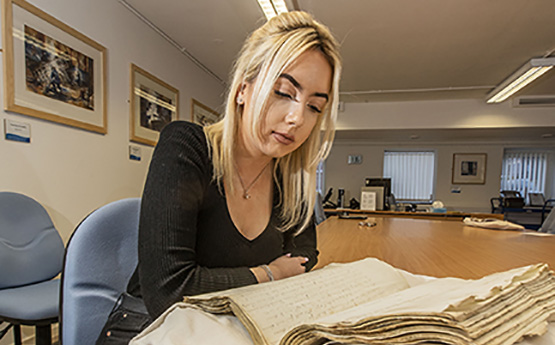
A perfect microcosm of wider society
Swansea University opened at a time where increasing numbers of students were accessing higher education, bringing with them more diversity and multifaceted experiences of student life.
As a Welsh institution, Swansea University adds to the wider historiography as many historians tend to write about students from flagship universities. It is important for Swansea to be part of the discussion as it is a perfect microcosm of larger society and the prevalent themes of the 20th century – such as gender boundaries, youth culture, war, and activism.
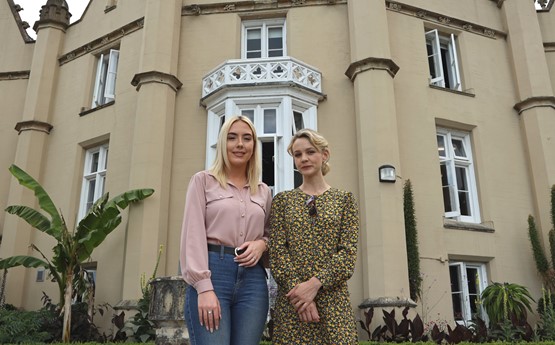
Jay Rees with Carey Mulligan, whose grandfather studied at Swansea University, outside Singleton Abbey.
Early emergence of student culture
From the outset, students bought in to a ‘university culture’ through extracurricular activities.. The first societies opened in 1920, and whilst they were departmentally based, such as the Metallurgy Society and the Pure Mathematics Society, through their formation and the establishment of a student representative committee, a university culture flourished as early as the 1920s.
Navigating gender boundaries
Although women attended the University in 1920, they were still in a predominantly male environment and navigated different spaces to their male counterparts, which was reflective of wider 1920s culture.
The female common room was located in the attic of the Abbey, with their first social involving drinking tea and playing musical instruments amongst dainty floral decor. The male common room however, with its robust furniture, was nearer to the building’s entrance, with their housewarming quickly turning into hijinks.
In 1923, it became compulsory for women to live in Beck Hall, which was located 15 minutes from campus. Whilst the Refectory was a mixed area, women were required to return to Beck Hall to dine, twice a day, which was a way of stopping genders from mixing.
During the RAG, men would dress up in ‘bedazzling gowns’ whilst women would walk alongside the floats wearing academic dress and undertake charitable collections as it was deemed that hijinks was far too corrupting for the female personality.
Student life flourished in times of adversity
During WW2, you may assume student life came to a halt due to blackouts, air raids and the Blitz, however this was not the case and in some areas, the university actually flourished and saw the creation of new traditions and stronger student culture.
In 1939, University College of London students evacuated to Swansea, adding 140 staff and students to Swansea’s cohort of 303 students. With them came new traditions, such as Foundation Week, whereby students participated in sporting events, plays and a dance, invigorating student life at the time that it was being tested.
This also gave the chance to make lasting changes to student dynamics. The first female SU President, Dorothy Jones, was elected in 1945, largely because activities moved to Beck Hall, a predominantly female space. One of the six houses was empty, so students agreed with the warden that it could be claimed as the Student Union building.
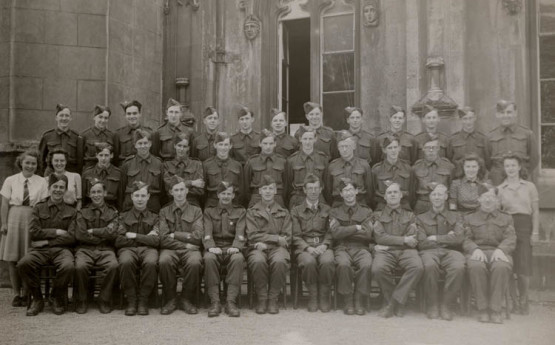
University College of Swansea Home Guard, c.1942. Courtesy of the Richard Burton Archives, Swansea University (reference: UNI/SU/AS/4/1/2:95)
There was a real sense of danger at this time because Swansea was being heavily bombed. 48 current or former students lost their lives in service during World War 2, and my thesis has a detailed appendix about all of those students.
Long-standing rivalry
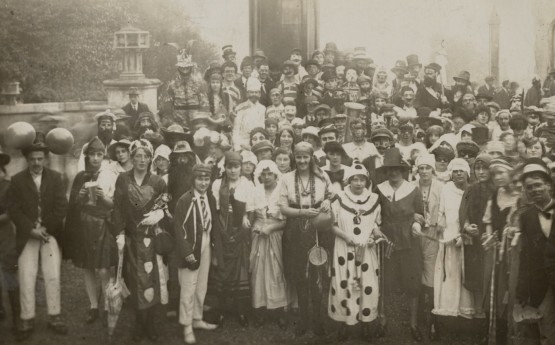
Students in Fancy Dress for RAG, 1922. Courtesy of the Richard Burton Archives, Swansea University (reference: UNI/SU/PC/5/5)
In the 1920s-30s, RAG was as an area of civic pride, however, despite its charitable donations, by the 1950’s; it became unwelcome in the community due to developing anxieties around youth culture.
In 1954, the rivalry we have come to know and love between Swansea and Cardiff recoloured how the community viewed the RAG. Swansea University’s Engineering Society made a flying saucer out of tinfoil as part of the parade, and dressed as though they were going to space. The students from Cardiff stole the saucer, taking it back to Cardiff and demanded ransom for its return, establishing a series of back and forth retaliation from both sides. From 1956 onwards, the University marshalled the event and we see a police presence.
Learning from former students
As we head into our next century, we remember the valuable lessons taught by our former students through their experiences. Lessons of resilience, determination and the ability to adapt and maintain a sense of student identity and community at times of adversity.
This resilience is particularly poignant given our current circumstances. We are going into a time when student life is going to look quite different and we are questioning what impact this will have on the student community.
Throughout our history, students have constantly pushed for a greater sense of community. Had they not done so, we would not have the Student Union and representation we have now.
During WW2, at the time we would have expected student culture to disappear, it was invigorated and there was a real sense of belonging to Swansea University. We might find that in these new times, student life flourishes again, albeit in a different way, with student identity becoming stronger.
Swansea helped me to push myself
Swansea University is in a beautiful location by the sea, offering everything you need from a city and university environment, combined with somewhere you would want to go on holiday. I studied both my Undergraduate degree and my Masters here and couldn’t imagine doing my PhD anywhere else.
Although you are researching your own subject, you are with other people in the same position. This enables you to forge connections outside of your area of research, expanding your horizons and perspectives.
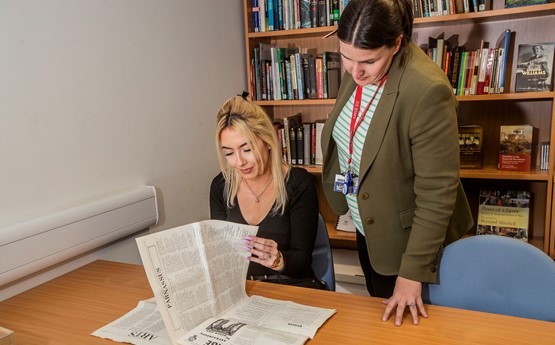
The History Department has fantastic academic expertise and provides such a supportive environment that I felt empowered to extend my interest in History; I always had a sense that I could push myself, and my research, further. As a historian, I cannot stress enough what a fantastic facility the Richard Burton Archives is and how helpful the archivists are. It is a treasure trove of information.
As a PhD student, you are encouraged to attend conferences and give papers, which can be incredibly daunting. Swansea, however, gives you the opportunity to develop these skills through departmental seminars and internal conferences, which have been integral to me building up the confidence to give papers at the Social History conference in London and the History of Education Society 50th Anniversary Conference in Winchester.
What comes next?
I am currently cutting up my thesis into journal articles and applying for research funding to pursue a career in academia.
My ultimate goal is to produce a monograph that looks at women’s experiences of student life across the University of Wales, exploring how they navigated different gender boundaries at a time when it was assumed that they had equal opportunities. I will be submitting a synopsis to a publisher very soon.
Find out more about Dr Jay Rees’ research by reading her Centenary essay Making Beds with Envelope Ends: Beck Hall and Women's Experiences of Student Life at Swansea University, 1920-1939 which takes a close look at the lived experiences of female students at the University during its early years.
